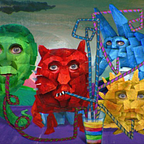All serious internal arts have a standing practice as their fundamental, foundational exercise.
Something like ‘Zhan Zhaung’.
The alignment of the body during this exercise is simply the most efficient posture to allow the maximum amount of muscular release, while retaining structural integrity.
Initially though, this posture cannot just be casually relaxed into. A lifetime of habitual postures and tensions mean that we need to use muscular force to pull ourselves into the correct but unaccustomed posture. The shoulders can be particularly difficult to set in the correct place, as a lot of tension tends to be stored there. They must be rotated, up, back and down and then held there. In time the body becomes accustomed to the correct posture and less force is required. The chest is ‘emptied’ and its corresponding area, the lower back, needs to ‘fill’.
The practitioner stands in position and releases muscular tension. This is not relaxation though; There is a separation. We voluntarily suffer as the muscles and flesh sink, in opposition to the skeletal structure which remains upright as if hung from above by a point on the skull at the top of the neck.
This release and the sinking feeling of one’s mass acted on by gravity is known as ‘song’. The muscles relax and our mass is transferred through to the floor: It does not catch in the muscles on the way down and the muscles feel as though they are hanging off the bone.
There is a second body, in Chinese Traditional Medicine it is known as the ‘huang’, a sinewy body, which develops through being stressed, just as the muscles naturally develop through stress. Our weight dropping applies stress to the huang, allowing it to develop.
The huang has a springy elasticated quality and, as it develops, it begins to press outwards along ‘sinew channels’ to the hands and feet.
Providing the muscles are released and ‘songed’ and the mass is sinking, the second body will eventually develop, becoming taut and connected, like wearing a tight elasticated wetsuit. Moving one part causes movement in the other parts. The huang is also much more conductive than the muscles, it can conduct awareness/ consciousness, which soaks into it like ink into blotting paper. The huang provides a physical anchor for awareness.
When performing the form (moving exercise), if the conditions of song and release are not in force and the huang is not under tension, taut and connected, then the movements will just be empty choreography. The form should almost feel as though it is moving itself because the integrated elasticated second body is the prime mover.
This development is often referred to as ‘steel wrapped in cotton’.
Apart from standing practice and the moving form, internal arts also have a set of joint loosening/ body opening exercises. These exercises are designed to loosen and separate tissue, allowing more flesh to become available for release in the standing practice; and also to stretch the fascia, encouraging sinew connection and development.
And so, the ‘elasticated’ and highly conductive huang becomes thoroughly saturated with ‘consciousness’. And in turn, a highly mobile, informational matter, that pushes and pulls, this way and that throughout the huang begins to be perceived and it is called chi or qi.
Chi resides at the sweet spot between matter and mind. The part of it that tends towards matter has a thick, tangible, circular, magnetic feel; The part that tends towards mind has a more ephemeral, linear, electrical feel. It stands astride the centre with its feet in both camps.
Gurdjieff named this ‘intelligent’ substance, Hanbledzoin, etymologically, ‘the sacred blood of life’, and likened it to ‘animal magnetism’.
He stated that it was the blood of the second-being-body, and that this second body is nourished by the air we breath as opposed to the physical body which is nourished by food.
“Substances required for the blood of the planetary body of the being enter into them through their ‘first-being-food,’ or, as your favorites say, ‘through food. But the substances needed both for coating and for perfecting the higher-being-body-Kesdjan enter into their common presences through their, as they say, ‘breathing,’ and through certain what are called ‘pores’ of their skin.”
